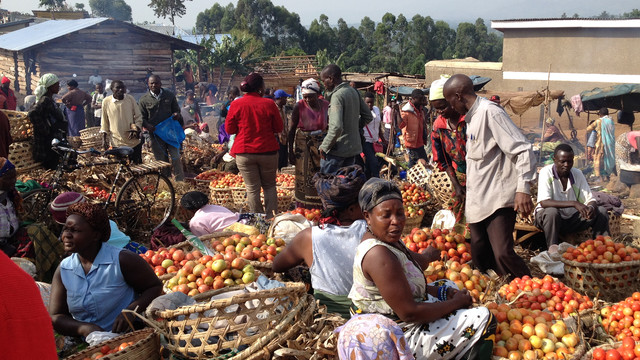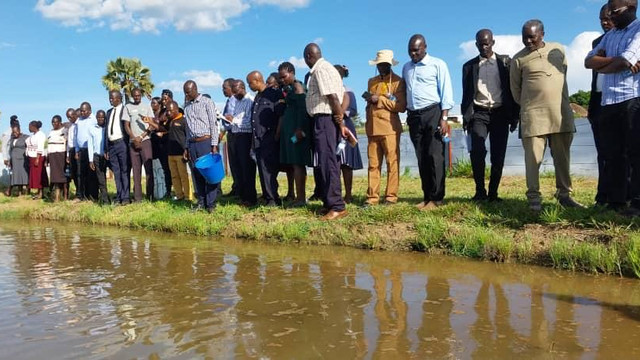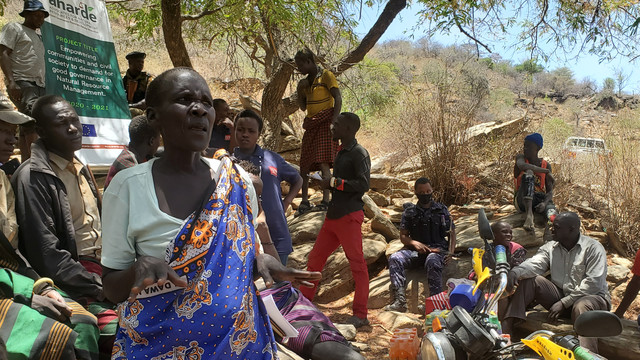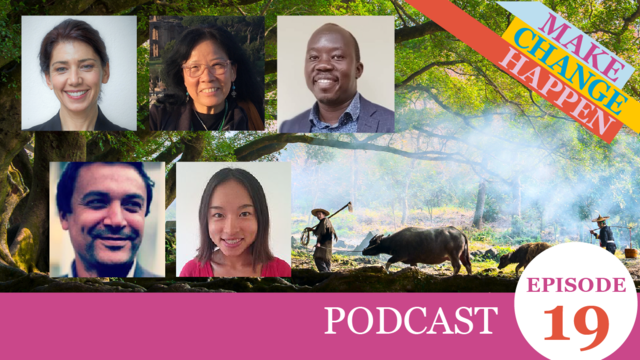Spinach soup, gorillas and cow dung baskets – what's the connection?
Tourism generates crucial revenue that helps conserve mountain gorillas and other species in Uganda. We're working to share the financial benefits with local people too, and help them develop better tourism products and services.


The sale of products such as these carvings of gorillas are an example of how local communities can benefit from tourism (Photo: Dilys Roe, IIED)
At Bwindi Impenetrable National Park, in Southwest Uganda, tourist numbers have increased from 1,300 a year in 1993 to around 20,000 today.
International tourists pay US$600 per head to track gorillas and the Uganda Wildlife Authority shares US$10 per permit sold with local people in recognition that their support is important for conservation. But beyond this, local benefits from gorilla tourism – such as jobs or sales of local products and services – are very limited.
Cow dung baskets: not always high on the souvenir list
There are a number of reasons for this. Many handicrafts, for example, attract only limited sales because they are poor quality or undesirable – cow dung baskets are not exactly on many international tourists' shopping list. Community-based enterprises are scruffy, which fails to give tourists confidence in quality or safety, while low levels of skills limit local people's job prospects or enterprise opportunities.
And because there's only limited interaction between tourists and local people, there are limited opportunities for sales: tourists tend to arrive at Bwindi with a guide on the afternoon of day one, spend one night at a lodge, spend the next day gorilla tracking and then leave the following morning.
As a result, despite Bwindi being a top tourist attraction, local economic development is extremely constrained. Relationships between local people and the park are poor, and poaching, snaring and other illegal activities continue.
This poses a significant threat to the park and to the long-term conservation of the mountain gorillas. It also represents a missed opportunity for harnessing tourism as an engine for local economic development in this remote rural area of Uganda.
Supporting microenterprises
To start addressing these problems, we are working with the Institute for Tropical Forest Conservation (ITFC), the Responsible Tourism Partnership (RTP) and the International Gorilla Conservation Programme (IGCP) to develop new or improved local tourism products and services that meet the needs and interests of tourists, tour operators and lodges. T
he project is called 'Local economic development through ‘pro-poor’ gorilla tourism in Uganda' and it is part of our work on biodiversity conservation and livelihoods.
During a scoping visit in August 2016, the team identified a number of micro-enterprises that were already showing great potential and that, with support to improve their quality and with better links to markets, could make a significant contribution to local economic development.
For example, a Batwa woman had been approached by a neighbouring lodge to grow spinach for soup, and subsequently set up a market garden. With support from our project, she and other Batwa women will be increasing the quantity and range of vegetables they produce and the number of lodges they sell to.
Elsewhere in Bwindi, artist Sanaa Gateja, from Kwetu Africa, will train a women's craft cooperative to produce baskets in shapes, sizes, colours and patterns that appeal to an international audience. And former poachers, who are now embarking on bee-keeping, will get product development help from Golden Bees, a commercial honey producer. A
further element is a Gorilla FriendlyTM eco-label, being developed in collaboration with the Wildlife Friendly Enterprise Network. Products and services with the label will follow three key principles. They will be high quality; be produced by people living within two kilometres of the park’s boundary (with the benefits shared equitably and transparently); and they will be produced in a way which does no harm to gorillas or to their habitat.Working directly with the private sector
A key feature of our project is that it directly engages with the private sector, including with lodge owners/managers and national and international tour operators.
Tourism organisations will be able to direct their clients to the new and improved products and services and, ideally, include these in their itineraries. The project is in early stages but has already attracted the Uganda Tourist Board’s attention and a growing network of tour operator partners.
 The sale of products such as these carvings of gorillas are an example of how local communities can benefit from tourism (Photo: Dilys Roe/IIED)
The sale of products such as these carvings of gorillas are an example of how local communities can benefit from tourism (Photo: Dilys Roe/IIED)
Feedback from the lodges has been positive too – an order for vegetables from a poachers-turned-market-gardeners' enterprise was agreed at our visit in February 2017, before training had even begun! At our last visit, in May, training was under way for honey producers and handicraft makers and a number of sites for potential cultural and nature trails had been identified.
It's early days, but signs are positive that this project will help harness tourism to benefit both local economic development and conservation.
This project is supported by the UK government's Darwin Initiative.




